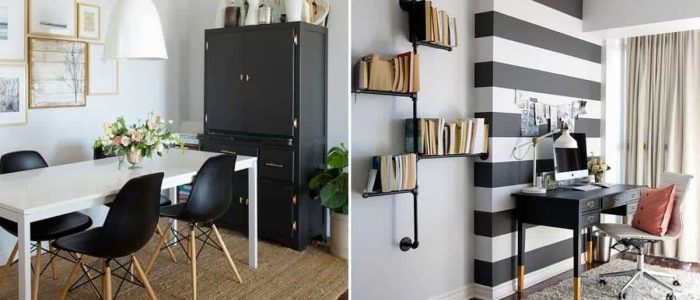Do you want to decorate your home and you don't know where to start? What are the essential tips for a successful decoration? What are the easiest and most affordable ways to achieve a spectacular decoration?
It's true: some people are born with a knack for decorating or designing. others learn these skills and are able to apply them successfully. Then there are most of us.
If you don't have much idea about design, with a few techniques you can go a long way.
These decorating rules and principles are simple and affordable for anyone to apply effortlessly. Your home will not look like the Casablanca, but it will look much more presentable.
Follow the rule of odd numbers
You may already know the rule of odd numbers in photography. Designing with an odd number as a base can create harmony and visual interest.
The essential idea of the rule is that details and objects are grouped or arranged in odd numbers to be more attractive, memorable and effective than even numbers.
It is useful for grouping objects of different heights, shapes and textures. At the same time, they have to have something in common. It may seem like a contradiction, but the idea is that there must be something that groups the objects together, but it is also important that each one has something slightly different.
Find the focal point of the room
The focal point of a room is its most prominent feature. It is what draws the attention of your gaze when you enter the room. Everything around the focal point is a mere complement.
If you don't know where to start when decorating a room, you can start by finding the focal point.
Many rooms have an integrated focal point, such as a large window with a view or a fireplace. If the room you want to decorate doesn't have a built-in focal point, you can create one by following these steps:
- Paint a wall a different color and add some pictures or bookshelves.
- Think carefully about what use you are going to give that room to be able to create the focal point from that. For example, if you're using the room for reading, it's a good idea to create the focal point using a bookcase.
- It's almost always a good idea to use a large piece of furniture as a focal point. Although it is also possible to use a work of art or a large mirror.
Once you have located the local point, you can start decorating the room around it. Use your main color in your elements throughout the entire room.
Once you are clear about the focal point, locating the center point will help you balance the room.
The focal point is the heart of your room design. It is not necessarily the center of the room, although it usually is in most houses. The midpoint of a dining room is where the table is located, with the chairs arranged around it.
Learn the essential measurement rules
Most people choose their curtains and furniture measurements on the go. However, there are some specific measures that will help you decorate your room with greater balance.
These are the general rules that you have to consider:
- Low table distance: Keep at least 50 cm between the coffee table and the sofas.
- Paintings: When hanging a piece of art, always keep it at eye level, which is usually 150 cm from the ground. If you are hanging multiple bodies, keep the center point at this level.
- If you are hanging any artwork above your sofa, make sure it does not exceed 2/3 of the width of the sofa. You should also leave a space of about 15-20 cm between the pictures and the furniture. Today, buying sofas made with pallets very cheaply online is also a decorative trend that is becoming the order of the day.
- Curtains: Normally, the curtains overlap the sides of the window from about 3 to 7 cm. Playing with this margin you can create the illusion that your windows look wider. You can also do it with their height.
- TV distance: The distance from the television to the sofa will depend on its dimensions. The best is the rule of thumb: multiply the diagonal size of your TV by two. That is the number of centimeters that you should keep between the TV and your sofa.
For rugs, there are three basic principles that you can take advantage of.
All inside: If your rug is big enough, you can put all the legs of your furniture on top. Still, you should leave a 30-50cm margin on each side.
All outside: If your room is small, you could opt for a smaller rug and keep all the legs of your furniture off the surface. You don't want to make your rug look small or insignificant like a doormat.
In front: Many designers choose to place only the two front legs on the carpet. This can make it all blend together and create a feeling of spaciousness.
Again, all of these tips mean something very important: don't be afraid to break these rules. They don't always work, although they are usually a great guide to follow.
Consider your negative space
Many times they say that less is more. In design, negative space is the area that is not being used. This is usually the blank area on your walls. It's tempting to fill in this space with something, but sometimes, the negative zone speaks for itself.
When we write, the phrases contain extra words that if they did not exist, the phrase would just sound good. Train yourself to find those moments in your own home.
Decorating negative spaces can be risky, but there are a few ways anyone can use:
Avoid chaos: The star method to decorate negative space. Even if you have a lot of space on your table, it does not mean that everything has to be there. Leave some negative space.
Be intentional: Make sure the negative space has a purpose. You can leave an empty space to highlight a decorated area next to it. Or maybe the simple negative space creates an interesting design.
Look at the shapes: Two contrasting shapes can create a strange or original negative space. A curved coffee table to soften the straight lines of the sofas and chairs. However, this concept may not work in smaller rooms.
Illuminate by layers
When it comes to lighting, there are several things you should keep in mind. The first is to learn that there are three basic types of lighting.
- Atmosphere: Also called general lighting and is dedicated ceiling lighting to evenly illuminate the room.
- Homework: As its name suggests, this lighting is designed for a specific task. A lamp in the living room could turn the area into a reading area. The Light under the kitchen furniture can help you when you cook.
- Accent: This lighting is aimed at highlighting a particular object. Like a painting or a work of art.
Adding different types of lighting can give you a new dimension to the room. Start with the mood lights in each room, and then consider how you could use the other types of lighting.
Beyond these tips, you may also want to put the house to your liking. With this guide you will have the necessary help to get started, but you will have to adjust the decoration according to your own tastes and preferences. Use these rules to get started, but don't be afraid to contradict them to follow your instincts if you feel that something must be otherwise.


